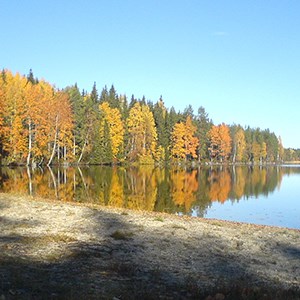More reading

For those who want to read more about how soil moisture maps can be used in forestry and the research that underlie the maps, here are links to a number of articles.
The method development of the map is described in the article:
Ågren, A. M., J. Larson, S. S. Paul, H. Laudon, and W. Lidberg (2021) Use of multiple LIDAR-derived digital terrain indices and machine learning for high-resolution national-scale soil moisture mapping of the Swedish forest landscape. Geoderma 404, 115280, https://doi.org/10.1016/j.geoderma.2021.115280
A guide to using wet area maps in forestry
The first 4 studies that are the basis for the development of the soil moisture maps:
- W Lidberg, M Nilsson, A Ågren (2019) Using machine learning to generate high-resolution wet area maps for planning forest management: A study in a boreal forest landscape, Ambio 49 (2), 475-486.
- W Lidberg, M Nilsson, T Lundmark, AM Ågren (2018) Evaluating preprocessing methods of digital elevation models for hydrological modelling, Hydrological Processes 31 (26), 4660-4668.
- AM Ågren, W Lidberg, E Ring. (2015) Mapping temporal dynamics in a forest stream network—implications for riparian forest management, Forests 6 (9), 2982-3001.
- AM Ågren, W Lidberg, M Strömgren, J Ogilvie, PA Arp. (2014) Evaluating digital terrain indices for soil wetness mapping - a Swedish case study. Hydrology & Earth System Sciences 18 (9).
The importance of scale for mapping soil moisture:
- Leach, J. A., W. Lidberg, L. Kuglerová, A. Peralta‐Tapia, A. Ågren and H. Laudon (2017) Evaluating topography‐based predictions of shallow lateral groundwater discharge zones for a boreal lake–stream system Water Resources Research. 53 (7) 5420–5437.
In addition to this, we can show that the maps actually capture small groundwater discharge areas:
- Leach, J. A., W. Lidberg, L. Kuglerová, A. Peralta‐Tapia, A. Ågren and H. Laudon (2017) Evaluating topography‐based predictions of shallow lateral groundwater discharge zones for a boreal lake–stream system Water Resources Research. 53 (7) 5420–5437.
And that these groundwater discharge areas are important for species diversity in the riparian zones along streams:
- Kuglerová, L., R. Jansson, A. Ågren, H. Laudon and B. Malm-Renöfält (2014a) Groundwater discharge creates hotspots of riparian plant species richness in a boreal forest stream network, Ecology, 95, 715-725, DOI: org/10.1890/13-0363.1 Det bör således påverka hur kantzonen skyddas på bästa sätt:
- L Kuglerová, A Ågren, R Jansson, H Laudon. () Towards optimizing riparian buffer zones: Ecological and biogeochemical implications for forest management. Forest Ecology and Management 334, 74-84.
It is therefore wise to consider local groundwater discharge areas when designing protection zones around watercourses:
- H Laudon, L Kuglerová, RA Sponseller, M Futter, A Nordin, K Bishop, T Lundmark, G Egnell and AM Ågren. The role of biogeochemical hotspots, landscape heterogeneity, and hydrological connectivity for minimizing forestry effects on water quality. Ambio 45 (2), 152-162.
Taking into account the local groundwater discharge areas is a cost-effective solution to optimize the benefit to the environment and biodiversity as valuable forest rarely stands on these lands:
- Tiwari, T., J. Lundström, L. Kuglerová, H. Laudon, K. Öhman and A. M. Ågren (2016) Cost of riparian buffer zones: A comparison of hydrologically adapted site‐specific riparian buffers with traditional fixed widths. Water Resources Research 52 (2), 1056-1069.
